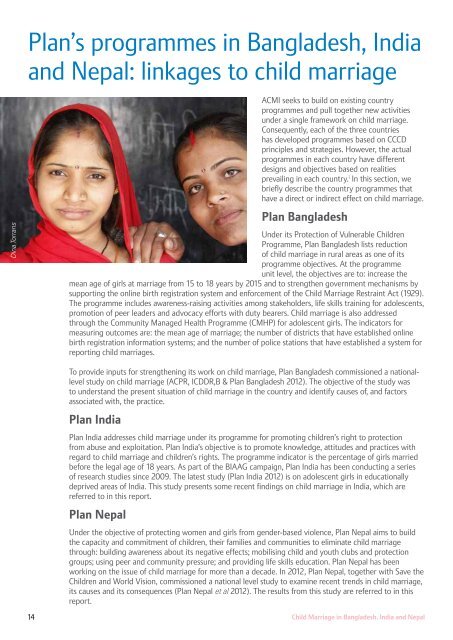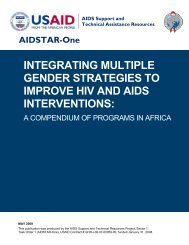Asia Child Marriage Initiative: Summary of Research in ... - ICRW
Asia Child Marriage Initiative: Summary of Research in ... - ICRW
Asia Child Marriage Initiative: Summary of Research in ... - ICRW
You also want an ePaper? Increase the reach of your titles
YUMPU automatically turns print PDFs into web optimized ePapers that Google loves.
Plan’s programmes <strong>in</strong> Bangladesh, India<br />
and Nepal: l<strong>in</strong>kages to child marriage<br />
D<strong>in</strong>a Torrans<br />
ACMI seeks to build on exist<strong>in</strong>g country<br />
programmes and pull together new activities<br />
under a s<strong>in</strong>gle framework on child marriage.<br />
Consequently, each <strong>of</strong> the three countries<br />
has developed programmes based on CCCD<br />
pr<strong>in</strong>ciples and strategies. However, the actual<br />
programmes <strong>in</strong> each country have different<br />
designs and objectives based on realities<br />
prevail<strong>in</strong>g <strong>in</strong> each country. i In this section, we<br />
briefly describe the country programmes that<br />
have a direct or <strong>in</strong>direct effect on child marriage.<br />
Plan Bangladesh<br />
Under its Protection <strong>of</strong> Vulnerable <strong>Child</strong>ren<br />
Programme, Plan Bangladesh lists reduction<br />
<strong>of</strong> child marriage <strong>in</strong> rural areas as one <strong>of</strong> its<br />
programme objectives. At the programme<br />
unit level, the objectives are to: <strong>in</strong>crease the<br />
mean age <strong>of</strong> girls at marriage from 15 to 18 years by 2015 and to strengthen government mechanisms by<br />
support<strong>in</strong>g the onl<strong>in</strong>e birth registration system and enforcement <strong>of</strong> the <strong>Child</strong> <strong>Marriage</strong> Restra<strong>in</strong>t Act (1929).<br />
The programme <strong>in</strong>cludes awareness-rais<strong>in</strong>g activities among stakeholders, life skills tra<strong>in</strong><strong>in</strong>g for adolescents,<br />
promotion <strong>of</strong> peer leaders and advocacy efforts with duty bearers. <strong>Child</strong> marriage is also addressed<br />
through the Community Managed Health Programme (CMHP) for adolescent girls. The <strong>in</strong>dicators for<br />
measur<strong>in</strong>g outcomes are: the mean age <strong>of</strong> marriage; the number <strong>of</strong> districts that have established onl<strong>in</strong>e<br />
birth registration <strong>in</strong>formation systems; and the number <strong>of</strong> police stations that have established a system for<br />
report<strong>in</strong>g child marriages.<br />
To provide <strong>in</strong>puts for strengthen<strong>in</strong>g its work on child marriage, Plan Bangladesh commissioned a nationallevel<br />
study on child marriage (ACPR, ICDDR,B & Plan Bangladesh 2012). The objective <strong>of</strong> the study was<br />
to understand the present situation <strong>of</strong> child marriage <strong>in</strong> the country and identify causes <strong>of</strong>, and factors<br />
associated with, the practice.<br />
Plan India<br />
Plan India addresses child marriage under its programme for promot<strong>in</strong>g children’s right to protection<br />
from abuse and exploitation. Plan India’s objective is to promote knowledge, attitudes and practices with<br />
regard to child marriage and children’s rights. The programme <strong>in</strong>dicator is the percentage <strong>of</strong> girls married<br />
before the legal age <strong>of</strong> 18 years. As part <strong>of</strong> the BIAAG campaign, Plan India has been conduct<strong>in</strong>g a series<br />
<strong>of</strong> research studies s<strong>in</strong>ce 2009. The latest study (Plan India 2012) is on adolescent girls <strong>in</strong> educationally<br />
deprived areas <strong>of</strong> India. This study presents some recent f<strong>in</strong>d<strong>in</strong>gs on child marriage <strong>in</strong> India, which are<br />
referred to <strong>in</strong> this report.<br />
Plan Nepal<br />
Under the objective <strong>of</strong> protect<strong>in</strong>g women and girls from gender-based violence, Plan Nepal aims to build<br />
the capacity and commitment <strong>of</strong> children, their families and communities to elim<strong>in</strong>ate child marriage<br />
through: build<strong>in</strong>g awareness about its negative effects; mobilis<strong>in</strong>g child and youth clubs and protection<br />
groups; us<strong>in</strong>g peer and community pressure; and provid<strong>in</strong>g life skills education. Plan Nepal has been<br />
work<strong>in</strong>g on the issue <strong>of</strong> child marriage for more than a decade. In 2012, Plan Nepal, together with Save the<br />
<strong>Child</strong>ren and World Vision, commissioned a national level study to exam<strong>in</strong>e recent trends <strong>in</strong> child marriage,<br />
its causes and its consequences (Plan Nepal et al 2012). The results from this study are referred to <strong>in</strong> this<br />
report.<br />
14 <strong>Child</strong> <strong>Marriage</strong> <strong>in</strong> Bangladesh, India and Nepal

















